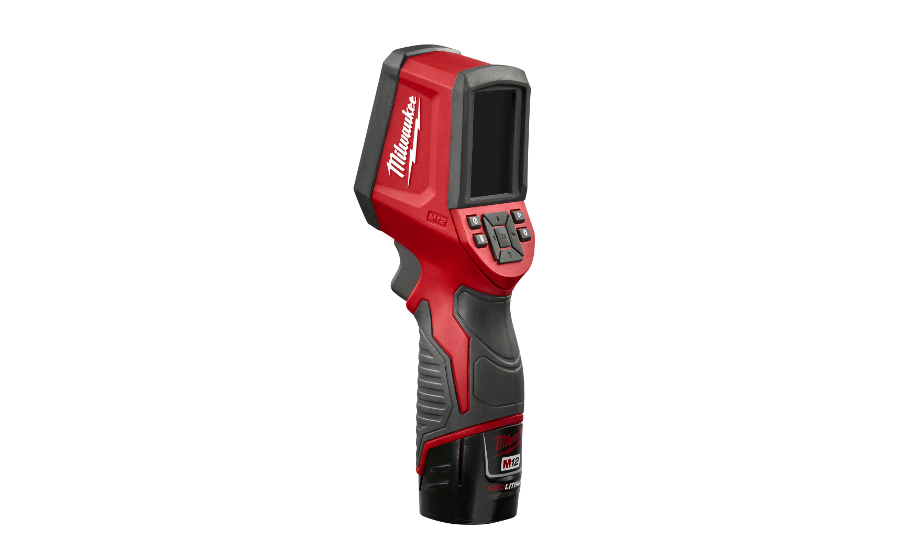Using thermal imaging to diagnose problems
Thermal camera technology can save time and money for you and your customers.

FLIR’s C2 is a full-featured, pocket-sized thermal camera, powered by a Lepton micro thermal detector, using 4,800 pixels of resolution. It features real-time image enhancement, a simple-to-use touch screen and rugged casing. Photo credit: FLIR

Ideal for service professionals, Milwaukee Tool's M12 7.8KP Thermal Imager features new DUAL SENSE pixel technology for superior definition of hot and cold details within the same image. Photo credit: Milwaukee Tool

Fluke’s 279 FC TRMS Thermal Multimeter integrates a full-featured true RMS digital multimeter with a thermal camera in one device to speed troubleshooting. Photo credit: Fluke

General Tools & Instruments PREDATOR series of thermal imaging cameras can identify areas of poor HVACR performance, locate invisible or inaccessible thermal leaks, pinpoint leak sources in piping or ductwork and check/monitor combustion or temperature-controlled processes. Photo credit: General Tools & Instruments




The cost of thermal imaging cameras and the way in which they are used has changed significantly over the past decade. The question here is how has this influenced the plumbing and heating industry and the way it uses the technology? Whether it is to enhance the work that contractors do or make their lives a whole lot easier, there is definitely room for the technology in the plumbing and heating industry.
What is thermal imaging technology?
Thermal imaging is defined as technology that produces an image of invisible (to the human eye) infrared light emitted by objects due to the heat, or lack of heat, in the object. This is called its “thermal condition.”
Why is it that more and more contractors and engineers are beginning to see the benefits of thermal imaging cameras on both a residential and commercial level?
• Affordable and time-efficient. To start off with, thermal imaging technology can display irregularities in the temperature distribution in minimal time, and in effect it is easy and straightforward to locate leaks and clogs in the piping. Due to the fact that a majority of affordable thermal imaging cameras are now handheld, they are a perfect sidekick for such tasks and easily can fit in a belt pouch.
• Noninvasive technology. As thermal imaging cameras do not need light or to be in physical contact with the area or object it is identifying, a simple thermal image can represent damaged pipework or hydronic heating blockages without having to physically be in the pipe or hydronic system. In a sense, the technology is the x-ray vision required for the job. There is no need for building disassembly in order to find which pipe is leaking; thermal imaging technology can locate leaks in seconds, saving contractors time and energy in the long run. Thermal imaging cameras save time and labor costs, as well as minimizing disturbance to building occupants.
• Return on investment and time. Just one camera is a great investment, advantageous for documenting jobs, and “before” and “after” shots. They are capable of producing customized reports, and validate the quality of a contractor’s repair. They can simply provide a quick diagnostic of heating system condition and performance without disturbing a customer’s home or work space. Most importantly, they can help plumbing and heating contractors identify problems before they become larger problems.
Thermal imaging cameras vs. infrared thermometers
Thermal imaging cameras can scan larger areas at ease and concisely, as opposed to basic single-spot temperature readings such as infrared thermometers are programmed to do. The image resolution of thermal imaging cameras is 80x60 pixels, which is the equivalent of using 4,800 infrared thermometers at once. Thermal imaging cameras are fully automatic; just point and shoot for JPEGs. They are compact and light, making them easy to store.
Most thermal imaging cameras have a digital video interface which transmits each temperature measurement pixel generated by the camera itself. This means not only can contractors take still thermal imaging photos, which can be analyzed in depth and used to improve the infrastructure in the future, but they can inspect the area in real time to identify the problem quickly and precisely.
Thermal imaging technology can revolutionize the plumbing and heating industry if more of the cameras are invested in.
For additional information on how these types of cameras can be used in the plumbing and heating industry, visit these websites:
• www.homewoodplumbing.co.uk/thermal-imaging-camera-leak-detection
• www.testolimited.com/thermal-imaging-for-plumbing-and-heating-contractors
• www.atp-instrumentation.co.uk/images/Introduction-to-Thermal-Imaging.pdf
Looking for a reprint of this article?
From high-res PDFs to custom plaques, order your copy today!












